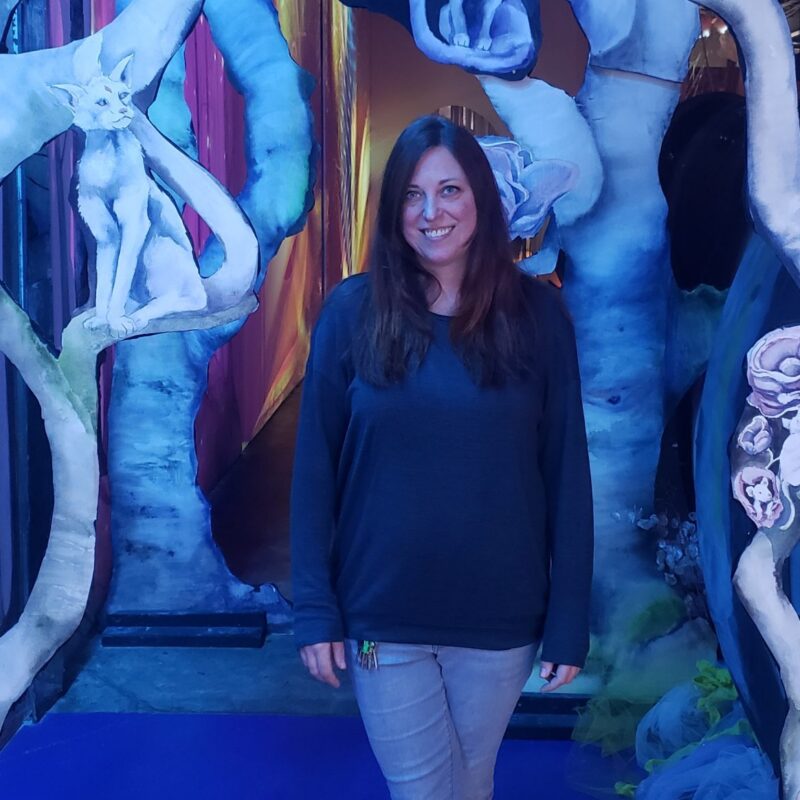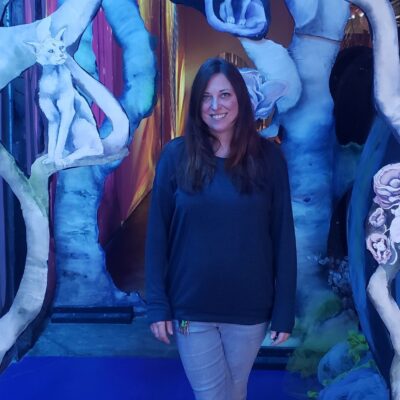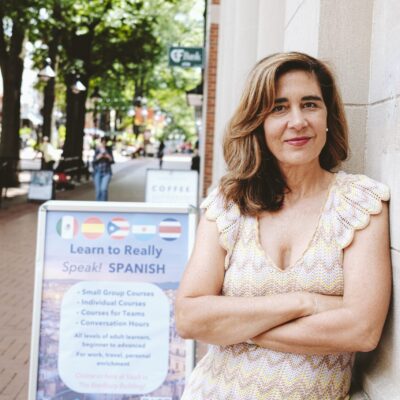ALLYSON MELLBERG and JEREMY TAYLOR
Artists and advocates of nontoxic art materials
If it’s not enough that Allyson Mellberg and Jeremy Taylor’s art focuses on the dysfunctional relationship between people and nature, consider what else they’re doing. According to Mellberg, most books about visual art focus on the kinds of toxic materials that artists should avoid. She compares this to “going to an all-meat restaurant as a vegetarian and just being told that there are no other options, so you just can’t eat.” She and her husband Jeremy Taylor—both of whose walnut-, squid- and spinach-ink sketches can be seen regularly around town—are working on a book that’ll be like a vegetarian menu of nontoxic materials. Get ready to dig in.
|
Local Food Hub co-founder Marisa Vrooman outside the office at Split Rock Farm. Besides consolidating distribution of local food, the organization runs a training farm in Louisa to entice a new generation of farmers. |
MARISA VROOMAN
Co-founder of the Local Food Hub
If Marisa Vrooman seems like a natural, it may be because all of her ancestors were farmers. She returned to Central Virginia last year looking to put her “energy and effort toward something that could really make a difference,” and a worthy foil presented herself in the form of Kate Collier, co-owner of Feast. Vrooman’s nonprofit know-how helped the two find the funding to found the Local Food Hub, which, a year later, has a staff of five and a refrigerated truck and consolidates local produce from 30 local farms so that farmers can sell in bulk. Virginia’s average farmer is pushing 60 years old, so Vrooman and Co. also run an educational farm in Louisa to spark interest in farming—or driving the refrigerated truck—real jobs that can be had with a high school degree.
FRED SCOTT
Philanthropist, Ballyshannon Fund
If Frederic Scott doesn’t fit the profile of a young, urban environmentalist it’s because he’s not one. When North Garden resident sold his Bundoran Farm to developers in 2006 for a cool $25.8 million, locals panicked that his 2,300 acres would sprout as many McMansions. But Scott handpicked a developer that would build enough to turn a profit while protecting 80 percent of the land. At the time, Scott cautioned against “‘good ideas’ to ‘protect the farms’” that come from those who “rarely have any idea of what it takes to operate such properties.” Scott took some of that money and through the Charlottesville Area Community Foundation founded the Ballyshannon Fund, which has since provided educational programming—including a popular lecture series at PVCC—on how to run “economically viable timber and agriculture operations.” It’s environmentalism without an “edge to it,” for the farmer, by the farmer.
DAVE NORRIS
Charlottesville Mayor
Even if he’s not Charlottesville’s purest conservationist, Dave Norris earns points for sticking to his guns when it comes to policy. He refused this year to replace an overused pipeline beneath McIntire Road because, he said, “when it comes down to it, for me at least, there is still the basic acknowledgement that this project is being designed to accommodate a new road [Meadowcreek Parkway] and an interchange that I cannot support.” In addition to staunch advocacy, Norris has big ideas for Charlottesville’s transportation future that include Platinum certification from the League of American Bicyclists—a distinction held by three American cities. “The future is in trying to create a more broad network of lane trails,” Norris said. Only three American cities have earned the distinction. For now, a humble bronze metal hangs from Charlottesville’s neck. Your go, Norris.
DAVID NEUMAN
UVA Architect
UVA Architect David Neuman has brought sustainability into a discussion that was once dominated by what critics called “nostalgia” for Jeffersonian flare. Under Neuman’s watch, most of UVA’s buildings have succeeded in staying true to Jefferson’s aesthetic vision while earning LEED certification. Neuman’s “Guidelines for Sustainable Buildings and Environmental Design” values the three “e”s (equity, economy and environment) that have spelled big change at the University, which under Neuman’s watch, has come to favor redevelopment over growth. If the University is left with something that’s more Jeffersonian in ideology than in aesthetic, so be it.
WATER STREET STUDIO
Design firm of the future
When planning commissioner Bill Emory referred to the city’s parks as “the liver and lungs of the city,” the folks at Water Street Studio, a local interdisciplinary design firm, took it literally: Landscape Architect Eugene Ryang says its hybrid landscape for the controversial McIntire Park YMCA will replace 50 trees with 125 and the innovative storm-water management design and permeable parking lot will return water to nearby creeks cleaner and more slowly than it enters now. They’re also working on edible landscapes for Buckingham County schools, and a 2,000-acre conservation project in West Virginia. Ryang says that most designers scoff when they hear the phrase “form follows function.” But in Water Street Studio’s work “form follows function thoughtfully, beautifully and sustainably.” Can’t argue with that.
|
Under Kendall Singleton’s direction, at UVA’s O-Hill Dining Hall trays are a thing of the past—and so is rampant food waste. |
KENDALL SINGLETON
Sustainability Coordinator for UVA Dining
Kendall Singleton holds the singular honor of holding a job at UVA that was invented for her. As an undergraduate, Singleton founded UVA’s Green Dining student group, which conducted a food audit that found diners with trays wasting 25 percent more food. The next year, like magic, trays were gone. This year Singleton returned to UVA as its first-ever sustainability coordinator for dining. Reusable take-out trays now compete with Styrofoam ones and dining halls are stocked with some local produce. Sound like baby steps? Maybe so. But she’s young, so give her some time.
KRISTEL RIDDERVOLD and CYNTHIA ADAMS
Charlottesville Administrative Coordinator and Charlottesville Climate Protection Programs Coordinator
Late in the summer, Charlottesville and Albemarle received a $500,000 grant from the Southeast Energy Efficiency Alliance, which enabled the Local Energy Alliance Program, an ambitious plan to retrofit buildings with renewable technologies. For this we can thank Cynthia Adams, the city’s climate protection programs coordinator, and Kristel Riddervold, the city’s environmental administrator. Through the efforts of Adams and Riddervold, at least a third of Charlottesville’s homes are slated to become at least 20 percent more efficient in five to seven years. C-VILLE reported this summer that when the program is launched this January, as many as half of local homes might get efficiency upgrades —all while creating 1,600 jobs.
MORGAN BUTLER
Southern Environmental Law Center Attorney
Whether he’s talking about the planned 1,400-acre Biscuit Run development, stormwater runoff or local roads, Morgan Butler has a way of opposing bad land policy without sounding self-righteous. The young lawyer is the Southern Environmental Law Center’s point man in opposing a costly Rte. 29 bypass that would cut through the county’s western edge. But, a realist, he privileges smart growth over no growth: The Places29 plan will begin to reform policies that once allowed “every new shopping center” to set up on 29N, “and try to dig [us] out of the hole.” When a large swath of dirt was left exposed during the construction of Hollymead Town Centre, causing a reported $1 million in damage to waters downstream, Butler helped get legislation past the Board of Supervisors that placed limits on the amount of time land can remain uncovered. If our future is green, it will probably have Butler’s fingerprints all over it.
ERYN BRENNAN
Albemarle County planner
As a senior planner for the county, a member of the Board of Architectural review and president of Preservation Piedmont, Eryn Brennan is in a unique position to let change wash over Charlottesville. She instead brings an environmentalist’s ethic to matters of historical preservation. “The greenest building is one that is already built,” she told C-VILLE this year. To that end, she helped inaugurate Preservation Week, which featured workshops on sustainability and preservation. And she’s rarely silent when a historic property is on the chopping block. As an advocate for the old, she does things in a new way.
JOHN SEMMELHACK
Founder, Think Little home energy audit/consulting business
As principal of Think Little, an energy consulting business and beyond, John Semmelhack would have you believe that slapping caulk around your baseboards can help you conserve natural resources. But his company, a home energy auditing business that offers “comprehensive home performance consultations,” proposes just that. If the house is leaky, “you’re taking the air that you spent a lot of money to heat up and sending it right outside,” Semmelhack told C-VILLE when the company was launched in 2007. Ditto for energy. Through his company Semmelhack has been spreading the gospel of passive energy conservation strategies that may sound like small potatoes, but spell big change.
|
Karen Waters stands in the “Garden of Goodness” at Friendship Court, which currently produces crimson clover, hairy vetch, collards, oats and rye. A rainwater harvesting system supplies the majority of the water for the garden’s irrigation system. |
KAREN WATERS
Executive Director, Quality Community Council
As executive director of the Quality Community Council—a “citizen-driven community coalition dedicated to improving the quality of life in Charlottesville’s most challenged neighborhoods”—Karen Waters might not seem to have much vested interest in environmentalism. But Waters applied the QCC charge to a series of urban farms. One farm at Friendship Court, for example, now serves low-income Charlottesvillians with organic produce, as well as nutritional and gardening know-how. There’s the added bonus that it’s a reclaimed green space. This is the kind of “everybody wins” scenario we hope to see from Waters for years to come.
BACK TO THE FEATURE STORY








